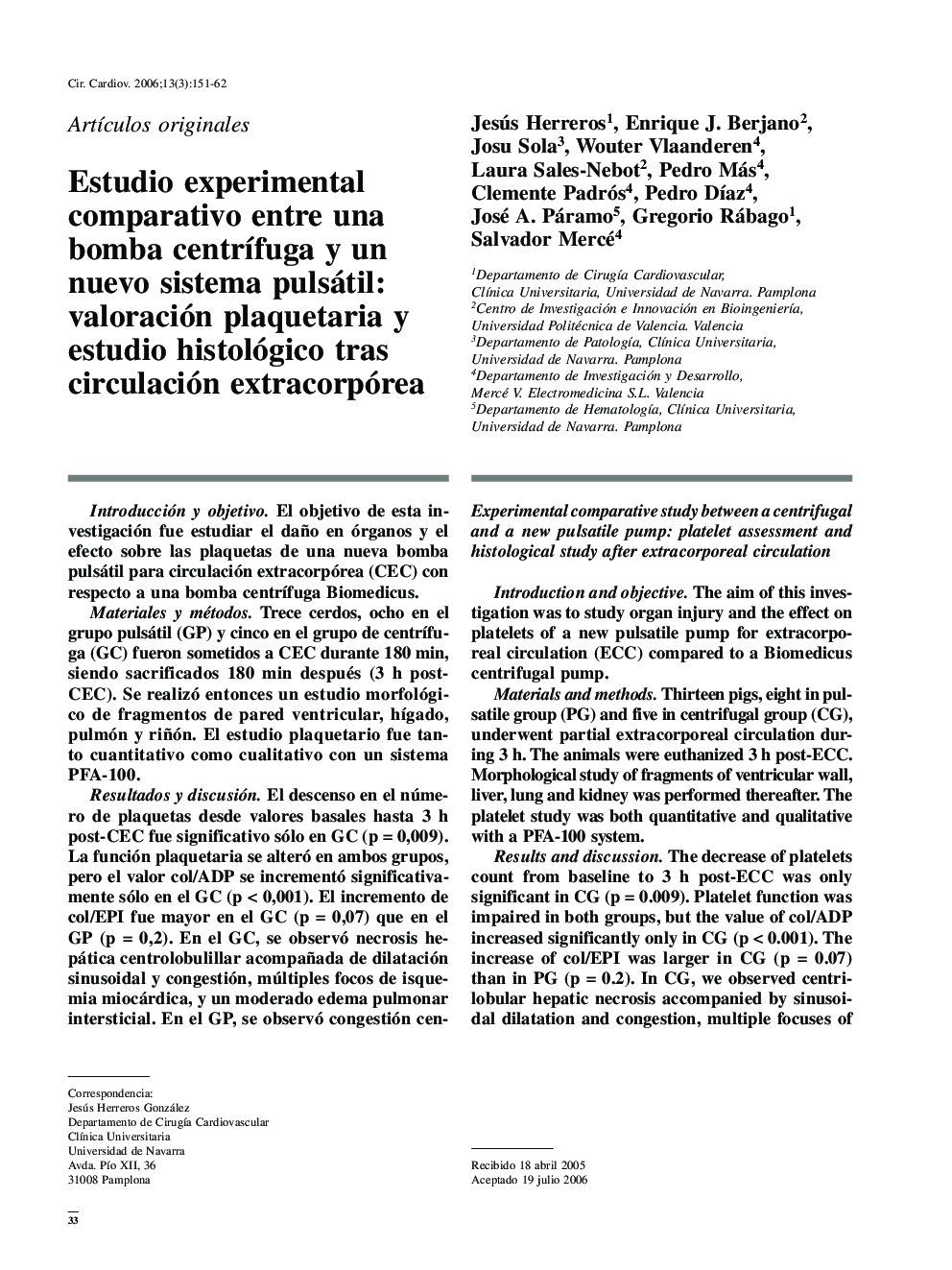| Article ID | Journal | Published Year | Pages | File Type |
|---|---|---|---|---|
| 2908208 | Cirugía Cardiovascular | 2006 | 11 Pages |
Introducción y objetivoEl objetivo de esta investigación fue estudiar el daño en órganos y el efecto sobre las plaquetas de una nueva bomba pulsátil para circulación extracorpórea (CEC) con respecto a una bomba centrífuga Biomedicus.Materiales y métodosTrece cerdos, ocho en el grupo pulsátil (GP) y cinco en el grupo de centrífuga (GC) fueron sometidos a CEC durante 180 min, siendo sacrificados 180 min después (3 h post- CEC). Se realizó entonces un estudio morfológico de fragmentos de pared ventricular, hígado, pulmón y riñón. El estudio plaquetario fue tanto cuantitativo como cualitativo con un sistema PFA-100.Resultados y discusiónEl descenso en el número de plaquetas desde valores basales hasta 3 h post-CEC fue significativo sólo en GC (p = 0,009). La función plaquetaria se alteró en ambos grupos, pero el valor col/ADP se incrementó significativamente sólo en el GC (p< 0,001). El incremento de col/EPI fue mayor en el GC (p = 0,07) que en el GP (p = 0,2). En el GC, se observó necrosis hepática centrolobulillar acompañada de dilatación sinusoidal y congestión, múltiples focos de isquemia miocárdica, y un moderado edema pulmonar intersticial. En el GP, se observó congestión centrolobulillar difusa en el hígado, congestión y dilatación capilar de baja intensidad en la pared ventricular, y edema septal pulmonar intersticial no significativo. En el riñón, ambos grupos mostraron cambios degenerativos de las célas tubulares.ConclusionesLa nueva bomba preserva bien las plaquetas en comparación con la bomba Biomedicus. Además, los resultados del estudio morfológico sugieren una mayor perfusión periférica en GP.
Introduction and objectiveThe aim of this investigation was to study organ injury and the effect on platelets of a new pulsatile pump for extracorporeal circulation (ECC) compared to a Biomedicus centrifugal pump.Materials and methodsThirteen pigs, eight in pulsatile group (PG) and five in centrifugal group (CG), underwent partial extracorporeal circulation during 3 h. The animals were euthanized 3 h post-ECC. Morphological study of fragments of ventricular wall, liver, lung and kidney was performed thereafter. The platelet study was both quantitative and qualitative with a PFA-100 system.Results and discussionThe decrease of platelets count from baseline to 3 h post-ECC was only significant in CG (p = 0.009). Platelet function was impaired in both groups, but the value of col/ADP increased significantly only in CG (p < 0.001). The increase of col/EPI was larger in CG (p = 0.07) than in PG (p = 0.2). In CG, we observed centrilobular hepatic necrosis accompanied by sinusoidal dilatation and congestion, multiple focuses of myocardial ischemia, and mild to moderate pulmonary interstitial edema. In PG, we observed diffuse centrilobular sinusoidal congestion in the liver, congestion and capillary dilatation of low intensity in the ventricular wall, and non significant pulmonary interstitial septal edema. In the kidney, both groups showed degenerative changes of tubular cells and non-significant tubular dilatation.ConclusionsThe new pulsatile pump preserves the platelets well compared to a Biomedicus pump. Moreover, these results suggest a better peripheral circulation in the PG.
